-
Paper Information
- Paper Submission
-
Journal Information
- About This Journal
- Editorial Board
- Current Issue
- Archive
- Author Guidelines
- Contact Us
American Journal of Operational Research
p-ISSN: 2324-6537 e-ISSN: 2324-6545
2015; 5(2): 39-46
doi:10.5923/j.ajor.20150502.03

A Partially Backlogging Inventory Model for Deteriorating Items with Ramp Type Demand Rate
Sushil Kumar , U. S. Rajput
Department of Mathematics & Astronomy, University of Lucknow, Lucknow, U.P. India
Correspondence to: Sushil Kumar , Department of Mathematics & Astronomy, University of Lucknow, Lucknow, U.P. India.
| Email: |  |
Copyright © 2015 Scientific & Academic Publishing. All Rights Reserved.
This work is licensed under the Creative Commons Attribution International License (CC BY).
http://creativecommons.org/licenses/by/4.0/

This paper presents an inventory model for deteriorating items with constant deterioration rate and ramp type demand rate. Shortages are allowed and completely backlogged for the next replenishment cycle. The backlogging rate of unsatisfied demand is assumed as a function of waiting time. The purpose of our study is to minimize the total variable inventory cost because if the total cost is minimum then profit will be maximum. A numerical example is given to demonstrate the developed model. Sensitivity analysis of the change of parameters is also given.
Keywords: Deterioration, Partial-backlogging, Shortages and ramp type demand rate
Cite this paper: Sushil Kumar , U. S. Rajput , A Partially Backlogging Inventory Model for Deteriorating Items with Ramp Type Demand Rate, American Journal of Operational Research, Vol. 5 No. 2, 2015, pp. 39-46. doi: 10.5923/j.ajor.20150502.03.
Article Outline
1. Introduction
- In most of the inventory models it has been observed that the demand rate is influenced by the amount of on hand inventory stock. Researchers developed their inventory models by considering demand rate is either constant or increasing, decreasing exponential functions of time, stock dependent and linear functions of time. The demand of newly launched products such as fashionable garments, electronic items and mobile phones etc. increases with time and later it becomes constant. In such type of products the concept of ramp type demand is introduced. The ramp type demand is a demand which increases up to a certain time and after that it becomes stable or constant.Deterioration is a major problem in any business organization because the products such as food grains , vegetables, medicines and alcohols etc. that are stored for future use always loose part of their values with passage of time then this phenomenon is known as deterioration, so deterioration cannot be avoided in any business organization. Hill [1995] first time developed an inventory model with ramp type demand rate. Mandal and Pal [1998] extended the Hill [1995] model by allowing shortage. Wu and Ouyang [2000] developed an inventory model with ramp type demand rate. Wu [2001] devoloped an EOQ model for weibull deteriorating items with ramp type demand function of time by allowing shortage and the backlogging rate is a function of waiting time for next replenishment cycle. Giri et al. [2003] developed a single item single period EOQ model for weibull deteriorating items with ramp type demand rate by allowing shortages which are completely backlogged and an infinite planning horizon. Manna and Chaudhari [2006] developed an order level inventory model with finite production rate and time dependent deterioration rate and the demand rate is a ramp type function of time by allowing shortages which are completely backlogged. Deng et al. [2007] proposed an inventory model for deteriorating items with ramp type demand rate. Panda et al. [2008] considered an order level inventory model for seasonal products with ramp type demand rate by allowing shortage. Singh and Singh [2008] developed a partially backlogging inventory model for deteriorating items with quadratic demand rate. Skouri et al. [2009] developed a partially backlogging inventory model for weibull deteriorating items with ramp type demand rate. Singh and Singh [2010] developed an inflationary partially backlogging supply chain inventory model for deteriorating items with ramp type demand rate. Singh et al. [2010] determine a replenishment policy for non-instantaneous deteriorating items with stock dependent demand and partial backlogging. Jain and Kumar [2010] considered an inventory model for three parameters weibull deteriorating items with ramp type demand rate by allowing shortage. Chang [2011] developed a partially inventory model for two parameters weibull deteriorating items with ramp type demand rate. Yadav et al. [2012] determine an optimal replenishment policy for a partially backlogging inventory model with ramp type demand rate. Karmakar and Choudhuri [2013] developed a partially backlogging inventory model with time varying holding cost and ramp type demand rate. Sakrar and Chakrabarti [2013] developed an order level inventory model with fuzzy type demand under two level of shortage. Bansal and Garg [2014] considered a partially backlogging inventory model for non-instantaneous deteriorating items with ramp type demand rate. The table I show that the variation of total average cost with respect to the change in parameter , table II show that the variation of total average cost with respect to the change in parameter
 , table III show that the variation of total average cost with respect to the change in parameter b and the table IV show that the variation of total average cost with respect to the change in parameter
, table III show that the variation of total average cost with respect to the change in parameter b and the table IV show that the variation of total average cost with respect to the change in parameter  . Figures II, III and IV give the variation of parameter
. Figures II, III and IV give the variation of parameter  and T with respect to the fixed value of
and T with respect to the fixed value of  and
and  , Figures V and VI give the variation of parameter
, Figures V and VI give the variation of parameter  and T with respect to the values of
and T with respect to the values of  and
and  , Figures VII, VIII and IX give the variation of parameter
, Figures VII, VIII and IX give the variation of parameter  and T with respect to the fixed value of
and T with respect to the fixed value of  and
and  . Figures X and XI give the variation of parameter
. Figures X and XI give the variation of parameter  and T with respect to the fixed values of
and T with respect to the fixed values of  and
and  .In this paper we developed a partially backlogging inventory model for deteriorating items with constant deterioration rate and ramp type demand rate. Shortages are allowed and completely backlogged for next replenishment cycle, the backlogging rate of unsatisfied demand is assumed as a function of waiting time. The ramp type demand is a demand which increases up to a certain time and after that it becomes stable or constant in the case of real estate, electronics items, fashionable garments and food grains etc. The purpose of our study is to minimize the total variable inventory cost for maximize the profit.
.In this paper we developed a partially backlogging inventory model for deteriorating items with constant deterioration rate and ramp type demand rate. Shortages are allowed and completely backlogged for next replenishment cycle, the backlogging rate of unsatisfied demand is assumed as a function of waiting time. The ramp type demand is a demand which increases up to a certain time and after that it becomes stable or constant in the case of real estate, electronics items, fashionable garments and food grains etc. The purpose of our study is to minimize the total variable inventory cost for maximize the profit.2. Assumptions and Notations
- We consider the following assumptions and notations corresponding to the developed model1.The ramp type demand rate is
 , where a is the initial demand rate and b a constant governing exponential demand rate and
, where a is the initial demand rate and b a constant governing exponential demand rate and  is the Heaviside unit step function of time defined by
is the Heaviside unit step function of time defined by  2.The demand dependent production rate is
2.The demand dependent production rate is  , where k is a constant.3.
, where k is a constant.3.  is the constant deterioration rate .4.
is the constant deterioration rate .4.  is the backlogging parameter.5.
is the backlogging parameter.5.  is the holding cost.6.
is the holding cost.6.  is the deterioration cost. 7.
is the deterioration cost. 7.  is the shortage cost.8.
is the shortage cost.8.  is the time of maximum inventory level.9.
is the time of maximum inventory level.9.  is the time of zero inventory level.10. T is the length of inventory cycle.11. The replenishment rate is infinite.12. Shortages are allowed and partially backlogged.13. The lead time is zero.14.
is the time of zero inventory level.10. T is the length of inventory cycle.11. The replenishment rate is infinite.12. Shortages are allowed and partially backlogged.13. The lead time is zero.14.  is the inventory at any time in [0,T].
is the inventory at any time in [0,T].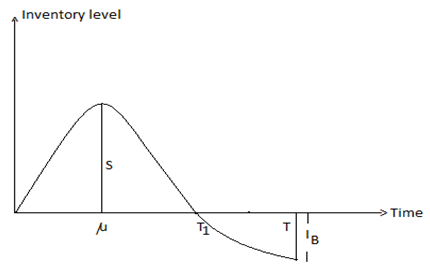 | Figure 1 |
3. Mathematical Formulation
- Let us consider an inventory system in which the production starts at t=0 and stop at
 . During the period
. During the period  the inventory level grows due to both production and deterioration and during the period
the inventory level grows due to both production and deterioration and during the period  the maximum inventory level decreases due to both demand and deterioration and becomes zero at
the maximum inventory level decreases due to both demand and deterioration and becomes zero at  . The shortage starts at
. The shortage starts at  and shortage interval is the end of current order cycle. The whole process is repeated and during the shortage interval
and shortage interval is the end of current order cycle. The whole process is repeated and during the shortage interval  the unsatisfied demand is backlogged at a rate of
the unsatisfied demand is backlogged at a rate of  , where t is the waiting time and the positive constant
, where t is the waiting time and the positive constant  is the backlogging parameter. The instantaneous inventory level at any time t in
is the backlogging parameter. The instantaneous inventory level at any time t in is governed by the following differential equations
is governed by the following differential equations | (1) |
 | (2) |
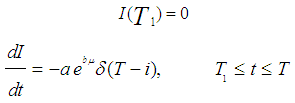 | (3) |
 The solution of equation (1) is
The solution of equation (1) is | (4) |
 | (5) |
 | (6) |
 in equation (4)
in equation (4) | (7) |
 is
is | (8) |
 is
is | (9) |
 is
is | (10) |
 | (11) |
 | (12) |
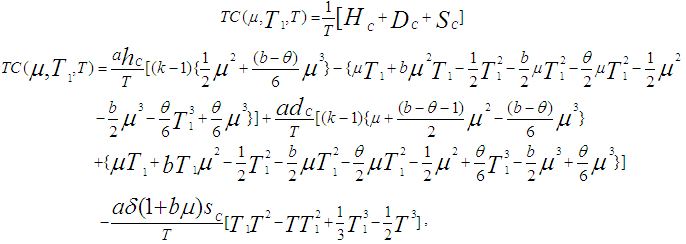 | (13) |
 to be minimum is that
to be minimum is that
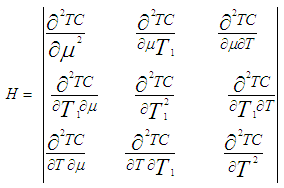
 and the sufficient condition is the determinant of the principal minors
and the sufficient condition is the determinant of the principal minors  of Hessian matrix (H-matrix), of
of Hessian matrix (H-matrix), of  are positive definite.
are positive definite. | (14) |
 | (15) |
 | (16) |
 | (17) |
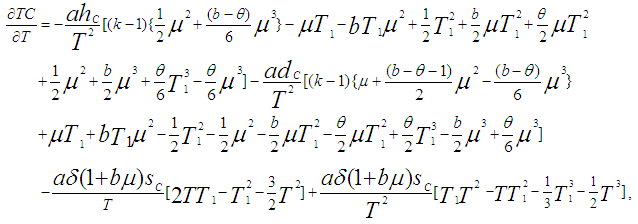 | (18) |
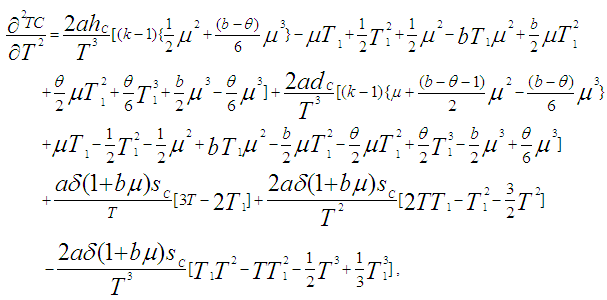 | (19) |
 | (20) |
 | (21) |
 | (22) |
 | (23) |
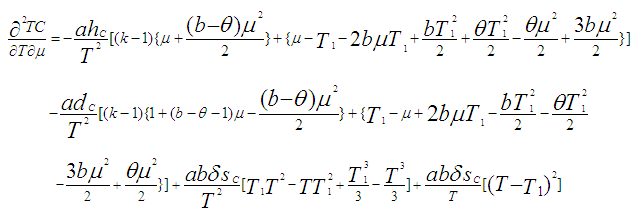 | (24) |
 | (25) |
4. Numerical Example
- Let us consider an inventory system with the given data in appropriate units as follows:

 , and the total variable inventory cost is TC = 76969.433039.Table 1 show the variation of total variable inventory cost with respect to the change in parameter
, and the total variable inventory cost is TC = 76969.433039.Table 1 show the variation of total variable inventory cost with respect to the change in parameter  .
.
|
 then the values of the parameters
then the values of the parameters  and T decreases and the value of TC also decreases.
and T decreases and the value of TC also decreases.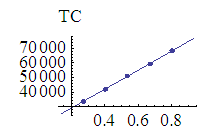 | Figure 2. ( , , and T are const.) and T are const.) |
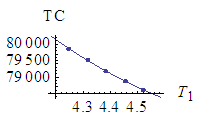 | Figure 3. ( , , and T are const.) and T are const.) |
 | Figure 4. ( , , and and  are const.) are const.) |
 .
.
|
 | Figure 5. ( , , and T are const.) and T are const.) |
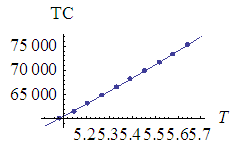 | Figure 6. ( , , and and  are const.) are const.) |
 then the values of the parameters
then the values of the parameters  and
and  remains constant, the value of the parameter T decreases and the value of TC increases. Table 3 show the variation of total variable inventory cost with respect to the change in demand parameter b.
remains constant, the value of the parameter T decreases and the value of TC increases. Table 3 show the variation of total variable inventory cost with respect to the change in demand parameter b.
|
 ,
,  and T decreases and the value of TC also decreases.
and T decreases and the value of TC also decreases.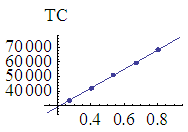 | Figure 7. (b,  and T are const.) and T are const.) |
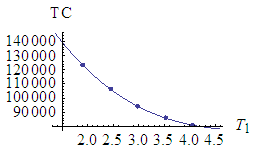 | Figure 8. (b,  and T are const.) and T are const.) |
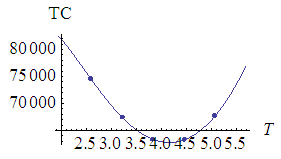 | Figure 9. (b,  and and  are const.) are const.) |
 .As we increase the parameter
.As we increase the parameter  then the values of the parameters
then the values of the parameters  and
and  remains constant, the value of the parameter T decreases and the value of TC increases.
remains constant, the value of the parameter T decreases and the value of TC increases.
|
 | Figure 10. ( , , and T are const.) and T are const.) |
 | Figure 11. ( , , and and  are const.) are const.) |
 then the values of the parameters
then the values of the parameters  ,
,  and TC decreases. From the table II we see that as we increase the backlogging parameterthen the values of the parameters
and TC decreases. From the table II we see that as we increase the backlogging parameterthen the values of the parameters  and
and  remains constant and T decreases and TC increases. From the table III we see that as we increase the demand parameter b then the values of the parameters
remains constant and T decreases and TC increases. From the table III we see that as we increase the demand parameter b then the values of the parameters  ,
, and TC decreases. From the table IV we see that as we increase the shortage cost
and TC decreases. From the table IV we see that as we increase the shortage cost  then the values of the parameters
then the values of the parameters  and
and  remains constant and T decreases and TC increases.Thus the parameters
remains constant and T decreases and TC increases.Thus the parameters  and
and  are more sensitive than the parameters
are more sensitive than the parameters , b,
, b,  and
and  (because for the change of the values
(because for the change of the values  and
and  the values of
the values of  ,
, and T comes out to imaginary).
and T comes out to imaginary). 5. Conclusions
- In this paper we consider a partially backlogging inventory model for deteriorating items with constant deterioration rate and ramp type demand rate. Shortages are allowed and completely backlogged for next replenishment cycle, the backlogging rate of unsatisfied demand is assumed as a function of waiting time. The change of the values of backlogging parameter
 and shortage cost
and shortage cost  gives the maximum value of total cost. Further this model can be generalized by considering time dependent holding and deterioration cost.
gives the maximum value of total cost. Further this model can be generalized by considering time dependent holding and deterioration cost. ACKNOWLEDGEMENTS
- The author would like to thank anonymous referees for their valuable comments and suggestions for the improvement of this paper.
 Abstract
Abstract Reference
Reference Full-Text PDF
Full-Text PDF Full-text HTML
Full-text HTML


